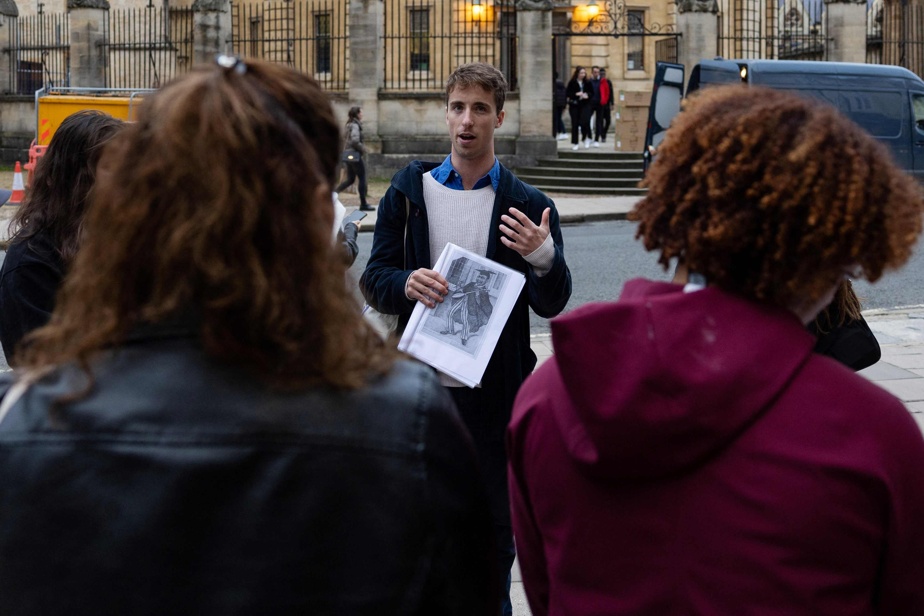(Oxford) They are constantly at the top of the rankings of the best universities in the world. But Oxford and Cambridge, whose creation dates back to the Middle Ages, also have their dark side, stories “hidden under the carpet” over the centuries, now brought to light in tourist visits.
“This is not a visit like any other,” warns the guide, university student Claire McCann, before setting off with her group into the streets of Oxford, which attracts around 7 million tourists each year. .
The majestic buildings are intact, despite the centuries that have passed, and bear witness to the opulence of the city.
Behind the high walls of the various Oxford colleges have studied most of the British prime ministers, the current head of the conservative government Rishi Sunak, Boris Johnson, Tony Blair, Margaret Thatcher, and the Labor leader Keir Starmer.
But that is not the subject of this visit, which is interested in “difficult legacies”, a hot topic in the United Kingdom, which has seen lively debates over its imperialist past in recent years.
First stop: Oriel College. On its facade sits the statue of Cecil Rhodes (1853-1902), a colonizer who dreamed of a British Africa from Cape Town to Cairo. He himself went through Oriel.
Slavery

PHOTO HENRY NICHOLLS, AGENCE FRANCE-PRESSE
Tour guide Oliver leads tourists participating in Uncomfortable Oxford outside the CarfaxTower.
Claire McCann, originally from South Africa, reads a quote, where he describes Africans as the “most despicable human beings.” It highlights its role in the Boer War (1899-1902). She recalls that he founded the De Beers company, still number one in the world in diamonds, and evokes the “exploitation” which took place in the mines.
The fortune thus amassed made it possible to create one of the most prestigious scholarships in the world, the Rhodes Scholarship, from which former American President Bill Clinton notably benefited.
“Should we keep this statue? », asks Claire McCann. Oxford decided in 2021, after the Rhodes Must Fall campaign which was launched by students and sparked lively debates across the United Kingdom: the statue will remain in place.
The group then goes to All Souls College, “the most exclusive of colleges” in Oxford, which only accepts two or three new students per year. It is also one of the richest. “Its prestige has been historically supported by […] slavery,” denounces Claire McCann.
All Souls has renamed its library, known to be one of the finest in the country, and which was named after a former student, Christopher Codrington. When he died in 1710, the latter left part of his fortune to the university, which came, writes All Souls on its site, “largely” from his family’s plantations in the West Indies, “where slaves worked ‘African origin’.
Flag at half mast

PHOTO HENRY NICHOLLS, AGENCE FRANCE-PRESSE
Tourists take the Uncomfortable Oxford guided tour.
The tourist visit also exists in Cambridge. “Did you know that Oxford and Cambridge together own more land than the Church of England? “, asks guide Ashley Lance, 27, as she walks along the quiet River Cam, opposite the sumptuous chapel of King’s College.
“According to a 2018 study, Cambridge is the city with the most inequality in Britain,” she continues. Because there are two worlds: that of the university, with its students, its professors, its laboratories, and the rest of the population.
Despite their rivalries – please don’t say the word Oxford in Cambridge, but rather say “the other place” – the two universities have many things in common.
Women were able to study at Oxford as early as 1870, but they had to wait until 1920 to qualify for a diploma. They were kept out of libraries for a long time, for fear that they would be “a distraction for men”, explains Claire McCann.
Oriel was the last college to open its doors to women, in 1985.
In Cambridge, St John’s College, founded in 1511, accepted women from 1980. But on the day the first female students arrived, a faculty official lowered the flag to half-mast and wore a black armband.
“It’s so shocking,” say, exasperated, a Londoner and her daughter, who have come to visit.
Michelle Miller, an American who has just moved to Oxford with her husband, says she is interested in the behind-the-scenes of tourist places: “We didn’t know there were all these controversies.”
These tours, called Uncomfortable Tours, started in 2018. Since then, more than 20,000 people have participated, according to the founders, and they are expected to expand to London and even Paris.
